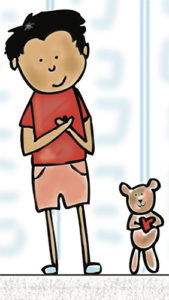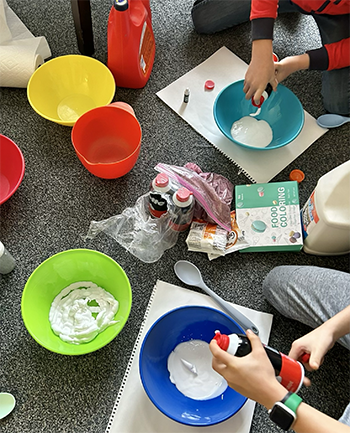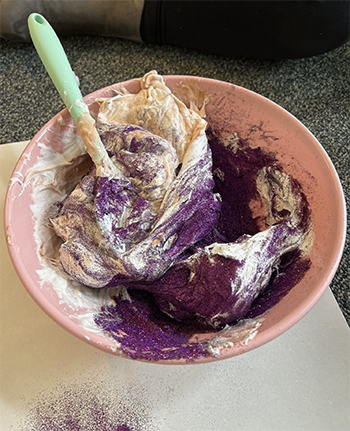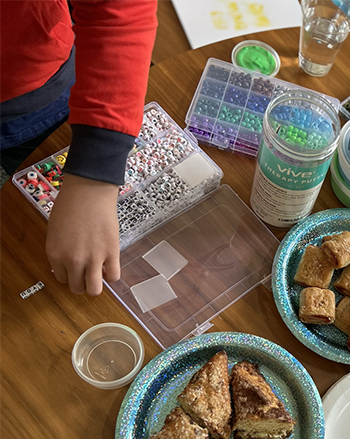How Does Play Therapy Help Adoptees and Therapists?
A Note from the Author
As an art therapist and a counselor, I find that play therapy significantly reduces pressure, especially when verbal engagement and conversation can feel intimidating and daunting. Play therapy acts as a medium for communication, rapport building, and the exploration of themes related to safety, abandonment, identity, and integration for adoptees.
—Carolyn Brazil, Clinical Intern at BPAR
Toys Are Like Words and Play Is the Language
In play therapy, toys are like the child's words, and play is the child’s language to create a form of communication with the therapist. This therapy is particularly beneficial for children who have experienced trauma, emotional difficulties, or developmental challenges. It provides a safe space for them to work through complex feelings such as fear, anger, sadness, or confusion.
It is often used for children who have experienced trauma, have social and emotional deficits, or are going through difficult transitions. A structured, theoretically based approach builds on the normal communicative and learning processes of children. Therapists strategically use play to help children express what is troubling them when they do not have the verbal language to express their thoughts and feelings.
This type of therapy is based on the idea that play is a child's natural medium of self-expression. It is a way for them to express their experiences and feelings through a natural, self-guided, self-healing process. Using toys, games, and activities, they can express thoughts and feelings that might be hard to put into words.
Role-Playing in Play Enhances Social-Emotional Learning
Play is an instinctive mode of communication for children, offering a window into their emotional states, behaviors, and interpersonal abilities. Use of play in therapy enables self-expression within a setting that is both familiar and comforting.
When role-playing different perspectives, children develop empathy and learn to understand and respect diverse viewpoints, which is essential for their emotional intelligence and social development. These activities also require children to express themselves and listen to others, thus enhancing their verbal and nonverbal communication abilities, which are crucial in various aspects of life. Moreover, engaging in decision-making scenarios enables children to develop critical thinking skills, as they learn to analyze situations and devise solutions, a competence that proves beneficial in both academic and social contexts. Finally, participating in role-play activities helps children build confidence in their ability to handle complex situations and express their opinions, boosting their self-esteem and preparing them for the challenges of real life.
Tapping into a child’s imagination not only facilitates emotional processing, but also advances their social skills and enables them to grasp complex ideas. Introducing children to scenarios that involve moral or ethical decisions can help them learn how to distinguish between right and wrong. As they consider the consequences and alternatives of their decisions, they gain a deeper understanding of ethical behavior. Specifically, role-playing activities involving ethical decision-making can be a profoundly effective resource for fostering children's growth and learning. Tapping into a child’s imagination not only facilitates emotional processing, but also advances their social skills and enables them to grasp complex ideas. In these role-playing activities, children are introduced to scenarios that involve moral or ethical decisions, helping them learn how to distinguish between right and wrong. As they consider the consequences and alternatives of their decisions, they gain a deeper understanding of ethical behavior.
Play Therapy Gives Any Therapist Added Insight
Art can be a form of play, and play can be highly creative. In some therapeutic settings, a session may start as play therapy and naturally progress into art therapy, and vice versa. For instance, a child may start by playing with toys to warm up and then move into drawing or painting to express deeper emotions or thoughts. Both types of therapy can be particularly effective because they allow the individual to create a physical representation of their inner world in a safe and supportive environment. This can involve drawing, painting, sculpting, and other art forms that allow children to tell their stories indirectly through the art they create during their play. Often, I like to start my sessions with a play warm-up such as hangman, Pictionary, or by drawing a feeling. This can be a powerful way to help children process complex emotions and experiences.
As an art therapist, my goal is not to simply assess the artwork superficially. By embracing the mantra “focus on the process, and not the product,” an art therapist who observes how a child engages with their selected methods of play as they create their art can significantly enrich their understanding of the child’s cognitive, social, physical, and emotional dimensions. This allows a deeper communication of feelings and thoughts the child artist might be conveying as they create their art. This practice aligns with the child's natural rhythm and developmental level, providing a considerate and empathetic channel that supports their journey towards growth and healing.
Art therapists can interpret a child's emotional and cognitive landscape by paying attention to their play preferences, including their selection of colors, the vigor of their engagement with art materials, and the narratives they enact.
Play Therapy with Puppets Can Address Complex Emotions
During my master’s program, puppet therapy was a central aspect of our curriculum, providing us with specialized instruction and training in this unique branch of drama and play therapy. This therapy, intersecting play and drama, has a rich history and specific clinical applications, benefiting a diverse clientele. My practical experience has shown that puppet therapy effectively separates an individual’s emotions and thoughts, easing the intensity of feeling them directly. By simulating scenarios, it lessens the direct pressure of expressing complex emotions. Clinically, I have seen how puppet therapy can facilitate profound emotional breakthroughs and encourage healthy detachment for self-reflection. For children, puppetry allows expression without fear of judgment, enabling them to process and articulate stressful events safely. Additionally, expressing oneself through a puppet can alleviate the stress associated with conveying challenging emotions. It permits for a degree of detachment from one's thoughts and feelings, which can make the process less overwhelming for many individuals. Thus, puppet play is invaluable in helping children project and work through emotions that may otherwise be overwhelming.
 See how Charlie, the narrator of our book, turned into a puppet for play therapy at BPAR!
See how Charlie, the narrator of our book, turned into a puppet for play therapy at BPAR!
Families who read our book, Adoption Is a Lifelong Journey, fell in love with Charlie, a young adoptee who is in touch with his emotions and is not afraid to express them. Charlie's illustrator, BPAR clinician Kelly DiBenedetto, decided to make a Charlie puppet to use in therapy at BPAR. Learn more in this video!
The Journey of Bringing Charlie to Life 0:59
Is There Such a Thing as Beneficial Play at Home?
Play therapy and the therapeutic benefits of playing, though they may sound similar, are quite different in their approach and application. Play therapy is a deliberate treatment approach for psychological issues with clinical goals and intentions, led by a trained therapist. But even regular, unstructured play that’s not under a therapist’s guidance may have natural, “therapeutic benefits.” Both regular play and play therapy promote stress relief, physical well-being, learning, and the development of cognitive and social abilities. Both also allow children to naturally navigate conflict and gain insights into their surroundings and self-discovery.
Play Therapy Can Help Clients of Any Age
Play therapy serves as a valuable technique for clinicians to connect with clients of any age, allowing them to communicate in a creative and comforting manner. Even adult clients can have difficulty finding the words to convey feelings, experiences, and ideas. This method doesn’t rely on a verbal exchange. I use many channels of self-expression as a form of play therapy within my practice. Often, I use role-playing as a means of building rapport, trust, and connection. For some individuals, verbalizing feelings and emotions can be intimidating, but playing serves to take the pressure off and can be familiar and comforting.
How Does Play Therapy Benefit Members of the Adoption Constellation?
As a counselor to adoptees, I find that play therapy significantly reduces pressure, especially when verbal engagement and conversation can feel intimidating and daunting. Play therapy acts as a medium for communication, rapport building, and the exploration of themes related to safety, abandonment, identity, and integration for adoptees.
Play therapy offers a non-threatening avenue for members of the adoption constellation to express and work through complex emotions. It plays a crucial role in fostering attachment and bonding within the adoptive family. Additionally, it serves as a helpful tool in addressing profound issues of grief, loss, and identity that can arise from the adoption experience. This form of therapy also aids in developing and reinforcing healthy coping strategies for dealing with emotional challenges. Furthermore, play therapy provides a unique platform for adoptive family members to communicate and gain a deeper understanding of each other's experiences and emotions connected to adoption.
Play therapy offers significant benefits for everyone involved in adoption. For adopted children, it creates a supportive space to explore their feelings about adoption and self-identity, helping them make sense of their history and place within their new family. It is also beneficial for older adoptees, including teens and adults, as it can be adapted to address complex issues such as feelings of abandonment, identity conflicts, and attachment difficulties. Furthermore, play therapy can be a valuable resource for birth parents, providing a way to work through intense emotions of sorrow and loss, mitigate feelings of guilt or worry, and help in reclaiming their sense of self beyond their biological ties to their child. Adoptive parents participating in play therapy sessions with their child can strengthen their bond and improve communication. Such joint activities can offer parents profound insights into their child's inner world, aiding in navigating the distinctive dynamics of adoptive parenthood. Moreover, extended family members also reap benefits from the ripple effects of play therapy. It equips them with more empathetic ways to engage with the adopted child, enhancing their understanding of the adoption process and contributing to a more unified family environment.
What's Going On in these Photos from Play Therapy at BPAR?

MIXING CUSTOMIZED SLIME
What are they using?
Group therapy members prepare their slime mixtures by combining Elmer's glue with shaving cream and starch in a plastic bowl. Then, they add a few drops of food coloring to reach their desired color, and then sprinkle in glitter for a sparkly effect. Finally, they add a small amount of laundry detergent to get their desired slime consistency, mixing thoroughly until smooth.
How are they using it?
Members choose how much food coloring and glitter to use as they customize their creations. They use mixing spoons to thoroughly blend the slime. The glitter not only adds sparkle but also allows each member to create a unique and personalized slime.

INTERACTING WITH THE SLIME
How are they using the slime?
Group members are using the slime as a sensory tool, as mediums like slime and clay can assist with sensory integration and regulation, helping individuals ground themselves in the moment. Often, the playful nature of sensory art therapy makes clients feel more comfortable and less intimidated when it comes to discussing and processing their feelings and emotions.
Members may choose to scoop up the slime with a whisk. This method is especially helpful for those who prefer not to get messy or dislike the texture of slime.
What does the slime demonstrate?
In this photo, art therapy is demonstrated as a form of play therapy, underlining the playful, sensory aspects of the practice. Here a group member has made her own slime, incorporating a lot of purple sparkle into the bowl, showcasing her playful, experimental approach rather than a methodical one. While some members may choose to measure the ingredients precisely, others, like in this photo, adopt a more free and relaxed approach with the materials. The process and how clients interact with these materials can reflect their thoughts, feelings, and even projections of their identities.

MAKING AFFIRMATION BRACELETS
What are they using?
In this photo, a group of adoptee children aged 8-11 are crafting affirmation bracelets with beads and lanyards, creating slogans and sayings that resonate with and affirm their identities.
How are they using it?
They are employing various beading techniques in different ways. Although not depicted, members have diverse approaches and methods of bracelet making. As a facilitator, it is important to honor all different forms of expression and creativity
What else is happening in the photo?
Alongside the bracelet-making materials, snacks and markers are also available, permitting the children the flexibility to alternate between drawing and beading activities. This open art therapy play space helps accommodate those who may struggle to focus on a single task, cultivating an environment that honors all forms of expression and creativity.
To summarize, play therapy is not just about using toys and games; it integrates the expressive power of artmaking within the play. It serves as a valuable technique to connect with clients, helping them convey their feelings, experiences, and ideas through artistic and playful expression, surpassing the need for verbal exchange, which can sometimes be a hurdle.
Written by Carolyn Brazil
Boston Post Adoption Resources